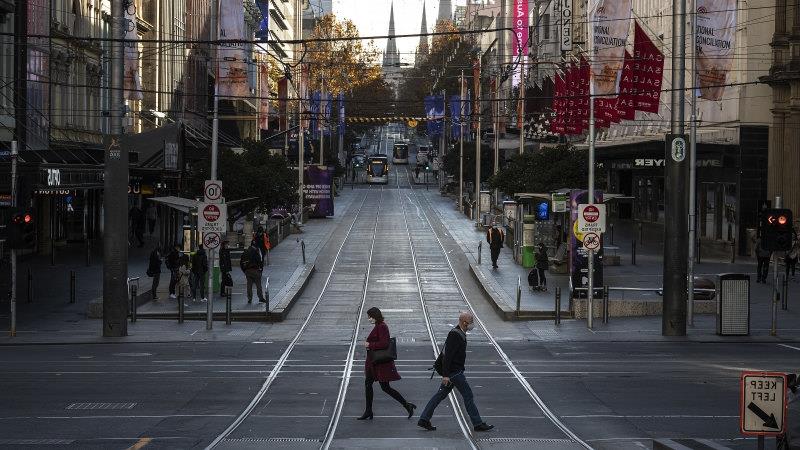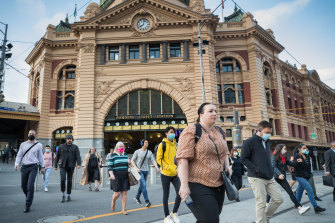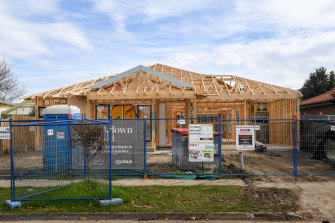For our free coronavirus pandemic coverage, learn more here.
At first glance, Victoria’s economy appears to have performed as well over the past decade (from 2009-10 to 2019-20) as it had done over the previous one.
Economic growth, as measured by real gross state product (GSP), averaged 2.4 per cent per annum, only slightly below the 2.8 per cent per annum it had averaged between 1999-2000 and 2009-10; 0.1 percentage points per annum above the national average (as against 0.3 percentage points below the national average over the preceding decade); and better than for any other part of Australia except for Western Australia and the ACT.
Over the past decade, Victoria’s economic growth had become increasingly dependent on population growth.Credit:The Age
But on closer inspection, it becomes apparent that, over the past decade, Victoria’s economic growth had become increasingly dependent on population growth, to a much greater extent than any other state or territory.
Over the 10 years to 2019-20, Victoria’s population grew at an average annual rate of 2 per cent – a significant step up from the 1.5 per cent per annum pace over the previous decade, and a similar margin above the national average (whereas during the first decade of the 21st century, Victoria’s population had grown at almost exactly the same rate as the national average).
The step-up in Victoria’s population growth rate over the past decade reflected Victoria’s success in attracting migrants both from other parts of Australia and from the rest of the world.
Whereas, between 1999-2000 and 2009-10, net interstate migration added an average of just 320 people a year to Victoria’s population, over the following decade almost 10,000 more people, on average, moved to Victoria from the rest of Australia each year than moved out. Between 2015-16 and 2018-19 this figure averaged 15,600 a year.
Victoria’s rapid population growth undoubtedly boosted the housing industry.Credit:Justin McManus
Likewise, over the past decade net migration from overseas added an average of almost 67,500 a year to Victoria’s population, more than half as much again as the 44,100 annual addition to Victoria’s population from net overseas migration during the previous 10 years. Between 2015 and 2019, Victoria was drawing fully 35 per cent of Australia’s total net migration intake, well in excess of 26 per cent share of Australia’s total population.
From one perspective, this attests to Victoria’s attractiveness as a place to live, work, study, raise a family or run a business.
And this rapid population growth undoubtedly boosted the housing industry – 81,300 (or 16 per cent) more homes were completed in Victoria during the 10 years to 2019-20 than in NSW, despite NSW’s population being some 25 per cent larger than Victoria’s – and retail sales, which grew at a faster rate in Victoria than in any other state over this period.
But it disguised what was a steady deterioration in Victoria’s economic performance in a more fundamental sense.
Expressed in per capita terms – that is, abstracting from the contribution made by population growth – Victoria’s economy grew by a mere 0.4 per cent per annum between 2009-10 and 2019-20.
That’s less than one-third of the rate at which Victoria’s per capita gross product grew over the previous decade. It’s less than half the national average per capita growth rate over the past decade, of 0.8 per cent. It’s the lowest of any state or territory other than South Australia.
As a result, Victoria’s per capita gross state product – a crude and imperfect but nonetheless widely used summary measure of its economic performance and a major determinant of Victorians’ material wellbeing relative to other states and territories – declined from just over 1 per cent above the national average 20 years ago, to almost 10 per cent below the national average in 2019-20. Only South Australia and Tasmania ranked lower than Victoria on this scale.
While some of this deterioration in Victoria’s overall per capita income relative to the national average reflects the influence on the latter of the extraordinary gains made by Western Australia as a result of its mining boom, it’s salutary to note that NSW’s per capita gross state product was only 0.5 per cent below the national average in 2019-20.
The only state with a lower per capita household disposable income than Victoria in 2019-20 was South Australia.Credit:Wayne Taylor
And lest it be though that gross state product is an abstract concept with little meaning for “ordinary” Victorians, the same Australian Bureau of Statistics estimates from which all of these figures are derived show that Victorian household disposable income per capita – which 20 years ago was within 1 percentage point of the national average – was in 2019-20 almost $3300 or 6.4 per cent below the national average. The only state with a lower per capita household disposable income than Victoria in 2019-20 was South Australia. NSW’s per capita household disposable income was by contrast more than $2000 above the national average, and more than $5300 (or 11 per cent) above Victoria’s.
In other words, by these metrics, Victoria has become a relatively poor state.
How can that have happened?
The main reason for this is that Victoria’s productivity performance – the growth rate of output per hour worked – has slowed much more than in any other state or territory (with the exception of South Australia).
As Victoria emerged from the depths of the early 1990s recession (which was much worse for Victoria than any other state), the productivity of Victorian workers increased at an average annual rate of 2.9 per cent – easily the fastest of any state or territory, and more than half a percentage point above the national average. Productivity growth slowed across all of Australia after the turn of the century, but Victoria’s rate of 1.1 per cent per annum was not far below the national average of 1.4 per cent (and marginally ahead of NSW).
But over the past decade, Victoria’s labour productivity growth rate slowed to less than 0.6 per cent per annum – barely more than half the national average, and less than in any other state or territory (including NSW).
Twenty years ago, Victorian workers produced about 3 per cent less than the national average by way of dollar value of goods and services for each hour that they worked. Ten years ago, that margin was 5 per cent. In 2019-20, the value of goods and services produced by Victorian workers for each hour that they worked was almost 10 per cent below the national average.
The connection between rapid population growth and declining productivity growth is probably that the growth in Victoria’s population over the past decade has been driven primarily by international students, young adults and lower-skilled migrants who are more likely to work part-time, and whose productivity is typically lower than that of more mature workers.
Unfortunately, Victoria’s mishandling of the COVID-19 pandemic – in particular, the decisions which Victoria made during the first wave, decisions which were very different from those taken by other states in the face of the same risks, which led directly to the disastrous second wave – and, I would say, the over-the-top policing of restrictions during last year’s second lockdown, is likely to have done some serious long-term damage to Victoria’s capacity to resurrect its pre-COVID growth model.
And I’m not the only one who thinks that. Projections published in Budget Paper No. 3 accompanying last month’s Federal Budget show that Federal Treasury expects net interstate migration to Victoria will average 7,825 per annum over the four years to 2024-25 – which is barely more than half the 15,600 per annum boost to Victoria’s population from that source between 2015-16 and 2018-19. It’s also likely that Victoria’s share of net overseas migration – when that resumes – will be less than what it was before COVID.
In short, the economic model which Victoria – consciously or unconsciously – adopted over the past decade is going to need replacement if the decline in Victorians’ incomes and living standards, relative to those of other Australians, over the past decade is to be stopped, let alone reversed.
Saul Eslake is former chief economist of ANZ Bank and of Bank of America Merrill Lynch in Australia, and is now principal of Corinna Economic Advisory based in Hobart.
Most Viewed in National
From our partners
Source: Read Full Article



